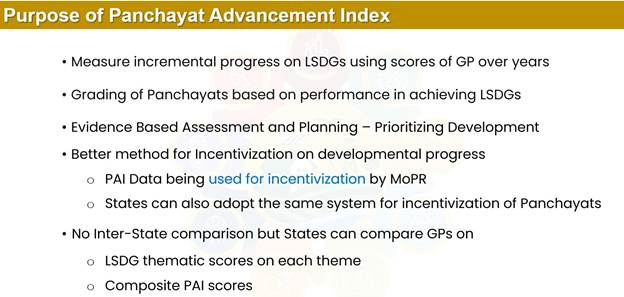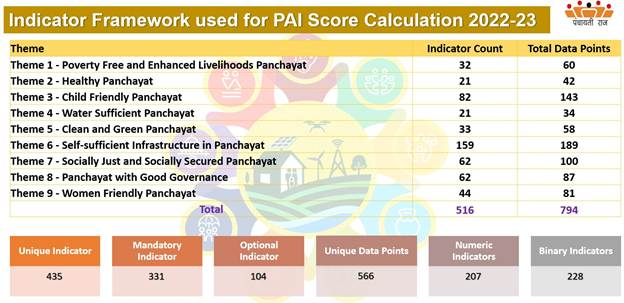Panchayat Advancement Index | 06 May 2025
For Prelims: Panchayat Advancement Index (PAI), National Panchayati Raj Day, National Indicator Framework, 73rd Constitutional Amendment Act, Geographic Information System
For Mains: Financial empowerment of PRI, Issues in Panchayati Raj Institutions, Sustainable Development Goals
Why in News?
Prime Minister Narendra Modi, on National Panchayati Raj Day (24th April), highlighted the Panchayat Advancement Index (PAI) as a key step toward empowering local governance and achieving Viksit Bharat 2047 by ranking 2.16 lakh panchayats on Sustainable Development Goals (SDGs) linked themes.
What is the Panchayat Advancement Index?
- About: PAI is a composite index designed to assess the performance and progress of Gram Panchayats (GPs) across India using socio-economic indicators, identifies development gaps, and supports evidence-based planning.
- It aligns with the Localization of Sustainable Development Goals (LSDGs) and the National Indicator Framework (NIF) developed by the Ministry of Statistics and Programme Implementation (MoSPI).
- It reflects India’s commitment to the SDG 2030 Agenda by promoting participatory, bottom-up governance, assessing GPs development through socio-economic indicators, identifying gaps, and enabling evidence-based planning.
- Indicators of the PAI: It is based on 435 unique local indicators across 9 LSDG-aligned themes.
- It is designed to provide a multi-domain and multi-sectoral assessment of Panchayat-level development.
- Data Collection and Validation: Over 2.16 lakh GPs from 29 States/Union territories (UTs) have entered data on the PAI Portal. Data entries are validated by respective States/UTs before inclusion.
- Performance Categories of GPs: Based on their PAI and thematic scores, GPs are classified into five performance categories: Achiever (90+), Front Runner (75–89.99), Performer (60–74.99), Aspirant (40–59.99), and Beginners (below 40).
- PAI data for 2022-23: Out of 2.56 lakh GPs, 2.16 lakh submitted validated data. No Panchayat qualified as an Achiever, while 0.3% were classified as Front Runners, 35.8% as Performers, 61.2% as Aspirants, and 2.7% as Beginners.
Constitutional Provisions Regarding PRIs
- 73rd Amendment Act, 1992: It granted constitutional status to PRIs, creating a three-tier system with provisions for elections, reservations, and devolution of powers across gram sabhas, panchayat samitis, and zila parishads.
- Part IX of the Constitution, added through the 73rd Amendment Act, 1992 and titled "The Panchayats," comprises Articles 243 to 243-O and lays down the structure, composition, elections, powers, and functions of PRIs.
- The 11th Schedule, also added by the same amendment, lists 29 subjects devolved to Panchayats, detailing their powers, authority, and responsibilities for effective local governance.
- Article 40 (Directive Principles of State Policy): It directs the State to organize village panchayats and empower them appropriately..
What are the Challenges Facing Panchayats?
- Limited Financial Autonomy: Panchayats rely heavily on state and central funds. According to an Reserve Bank of India study (2022-23), average revenue per Panchayat was Rs 21.23 lakh, but only 1.1% came from their own revenue sources (local taxes, fees).
- The 15th Finance Commission (2021–26) noted that only 8 states had constituted their 6th State Finance Commission (SFC), despite the due date being 2019–20. This continues to hinder the development and empowerment of Panchayats.
- Additionally, Local tax collection remains politically sensitive and administratively weak in GPs.
- Incomplete Devolution: The 73rd Constitutional Amendment Act, 1992 mandates the devolution of 29 subjects to Panchayati Raj Institutions (PRIs), but a 2022 Ministry of Panchayati Raj report revealed that less than 20% of states have fully implemented this transfer.
- Technological and Capacity Gaps: Lack of digital infrastructure and literacy hampers monitoring, evaluation, and data reporting.
- 12 states/UTs have 100% computer-equipped panchayats, but Arunachal Pradesh has none, and Odisha has only 13%. Internet access is also poor, with Haryana and Arunachal Pradesh reporting 0% and 1% connectivity, respectively.
- Many panchayats lack trained staff and technical advisors to design, monitor, and evaluate development plans.
- Inadequate Infrastructure: Only 7 states and UTs have 100% pucca (permanent) panchayat office buildings.
- Arunachal Pradesh has the lowest rate, with only 5% of its panchayat offices housed in pucca structures.
- Representation Gaps: Despite a 50% quota for women in panchayats, states like Madhya Pradesh, Haryana, Punjab, and Tripura fall short.
- Women make up 46.6% of elected representatives, but their participation is limited due to the "Pradhan Pati" issue, where male relatives often control decision-making.
- Patriarchal norms and bureaucratic neglect reduce women to figureheads in many states, particularly in northern regions like UP, Bihar, Haryana, and Rajasthan.
- Poor Inter-Departmental Coordination: Multiple government departments often function independently within the same village. Lack of convergence leads to duplication of work and inefficient resource use.
What Measures can Enhance the Effectiveness and Autonomy of Panchayati Raj Institutions (PRIs)?
- Ensure Financial Autonomy: States must effectively implement Article 243-I, forming a State Finance Commission every five years to assess finances and recommend tax distribution and suggest measures to improve Panchayats' financial health.
- Aligning with the L.M. Singhvi Committee (1986), which called for more financial resources for Panchayats, the adoption of RBI’s 2022 report on automated tax mapping via Geographic Information System (GIS) can significantly enhance tax collection at the Panchayat level.
- Devolution and Empowerment: States must adhere to the spirit of 73rd Constitutional Amendment by devolving the 29 subjects in the Eleventh Schedule effectively. Ensure timely and untied fund transfers to enable need-based planning.
- Boost Institutional Capacity: Enhance the Rashtriya Gram Swaraj Abhiyan (RGSA) to strengthen PRI capacity through targeted training for women and marginalised representatives.
- Promote convergence with Self-Help Groups (SHGs) and Community-Based Organisations (CBOs) to deepen community participation and local accountability.
- Technological and Data-Driven Governance: Integrate digital modules via BharatNet and Common Service Centres (CSCs) for continuous learning.
- Expand the usage of e-Gram Swaraj, which allows for digital planning, budgeting, and real-time monitoring of development works.
- Adopt a structured audit framework using the Local Government Directory (LGD) and performance tracking tools like the Mission Antyodaya dashboard.
- Encourage Scheme Convergence: Integrate key Central and State schemes like Mahatma Gandhi National Rural Employment Guarantee Scheme, Jal Jeevan Mission (JJM), and Swachh Bharat Mission (Grameen) through a unified, panchayat-level action plan.
- This approach enables need-based, locally tailored development instead of a one-size-fits-all model, ensuring greater relevance, efficiency, and impact at the grassroots level.
- Promote Gender Inclusion: Implement the recommendations of the 2013 Committee on the Status of Women in Panchayati Raj by establishing Women Resource Centres to support elected women representatives and address issues such as the ‘Sarpanch Pati’ phenomenon.
- Institutionalise gender budgeting and include disaggregated gender data in Gram Panchayat Development Plans (GPDPs).
|
Drishti Mains Question: Discuss the systemic barriers faced by Panchayati Raj Institutions in India and suggest reforms for empowering them as agents of grassroots development. |
UPSC Civil Services Examination, Previous Year Questions (PYQs)
Prelims
Q1. Local self-government can be best explained as an exercise in (2017)
(a) Federalism
(b) Democratic decentralisation
(c) Administrative delegation
(d) Direct democracy
Ans: (b)
Q. The fundamental object of Panchayati Raj system is to ensure which among the following? (2015)
- People’s participation in development
- Political accountability
- Democratic decentralisation
- Financial mobilisation
Select the correct answer using the code given below
(a) 1, 2 and 3 only
(b) 2 and 4 only
(c) 1 and 3 only
(d) 1, 2, 3 and 4
Ans: (c)
Mains
Q. To what extent, in your opinion, has the decentralisation of power in India changed the governance landscape at the grassroots? (2022)
Q. Assess the importance of the Panchayat system in India as a part of local government. Apart from government grants, what sources can the Panchayats look out for financing developmental projects? (2018)
Q. In absence of a well-educated and organised local level government system,`Panchayats’ and ‘Samitis’ have remained mainly political institutions and not effective instruments of governance. Critically discuss. (2015)



